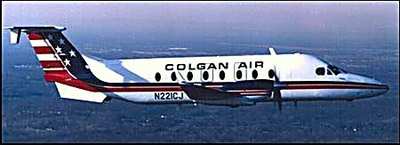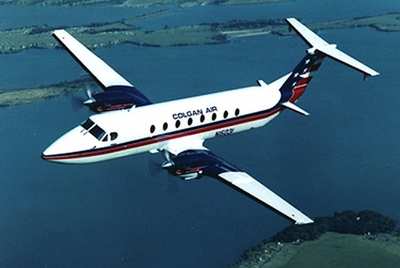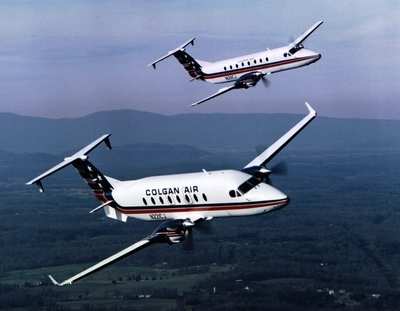NTSB Cites Maintenance Oversights, Lack Of Pilot Checks
 As is often the case in air
tragedies, it was a cacophony of errors that led to the downing of
a Colgan Air Beech 1900D off the coast of Cape Cod last year.
As is often the case in air
tragedies, it was a cacophony of errors that led to the downing of
a Colgan Air Beech 1900D off the coast of Cape Cod last year.
In its listing of probable cause in the August 26, 2003
accident, the NTSB cited a flight crew that didn't follow its
checklists, a faulty maintenance manual and mechanics who took what
turned out to be fatal shortcuts.
The Colgan Air Beech had just come out of maintenance when
Captain Scott Knabe and First Officer Steven Dean were assigned to
deadhead from Barnstable Municipal Airport in Hyannis (MA) to
Albany (NY). A team of four mechanics in Hyannis had replaced two
elevator trim actuators and a 55-foot long forward elevator trim
cable.
The NTSB report stated:
The two lead maintenance technicians that replaced the forward
elevator trim tab cable did not use a lead wire as instructed by
the AMM. They marked the topmost cable pulleys with a "T" instead.
A lead maintenance technician and the quality assurance inspector
stated that following the maintenance; a successful operational
check of the system was completed. They added that the operational
check included running the manual and electric elevator trim
several times, with the quality assurance inspector at the cockpit
and tailbone during different phases of the operational check.
Then there was the issue of the Raytheon Aircraft AMM manual
itself:
Review of the Beech AMM Chapter 27-30-04, "Elevator Trim Tab
Cables - Maintenance Practices," revealed that the trim drum was
depicted backwards. Although the drum could not be installed
backwards, it was possible to mis-route the cable around the drum,
and reverse the trim system. The depiction in the maintenance
manual showed the nose-up trim tab cable emanating from the aft end
of the drum, rather than the forward end. It also showed the
nose-down cable emanating from the forward end of the drum, rather
than the aft. However, the "FORWARD AS INSTALLED" arrow included in
the depiction would have to be ignored, and the cables would have
to be crossed once along the cable run, to reverse the system and
secure the cable ends into the turnbuckles.
Further review of the Beech AMM revealed that there was no
procedure for an operational check contained in Chapter 27-30-04.
Nor was there a referral to Chapter 27-30-09, "Elevator Trim -
Maintenance Practices...Elevator Trim Operational Check;" which did
contain a procedure for an operational check of the elevator trim
system.
It wasn't the first time Raytheon's Beech 1900 manuals had come
under fire. There were two fatal crashes that immediately followed
1900D maintenance. But Raytheon issued a statement Tuesday, denying
blame and instead pointing a finger at Colgan.
"As with any case, there are many details to consider and we
understand the NTSB's statement of probable cause to be factually
correct," said company spokesman Tim Travis. "Had the mechanic
performed a proper functional check as required by the maintenance
manual, the error would have been discovered."

From The Flight Deck
In addition to the maintenance and manual problems, the NTSB
report said Knabe and Dean failed to perform their "first flight of
the day" checks.
Further, the cockpit voice recorder showed the copilot failed to
disable the trim:
- At 1523:30, the captain called for the Before Start
checklist.
- At 1523:43, the first officer stated, "preflight's complete.
cockpit scan complete." The captain replied, "complete."
- At 1523:58, the first officer stated, "maintenance log,
release, checked the aircraft." The captain replied, "uhhhh.
maintenance and release on aircraft." The captain subsequently
identified that the DFDR was inoperative, and confirmed that the
minimum equipment list (MEL) was still open.
- At 1525:11, the captain began to start the right engine, before
being interrupted. Approximately 1 minute later, after a
conversation with maintenance personnel over the radio, the captain
resumed the starting of the right engine.
- At 1529:29, as the captain was starting the left engine, the
flight crew began non-pertinent conversation, which lasted about 30
seconds.
- At 1530:04, the captain called for the After Start checklist.
After completing the After Start checklist items, the first officer
announced the checklist "complete."
- At 1530:21, the captain continued the previous non-pertinent
conversation, followed 10 seconds later with, "all right we're
ready to taxi with HOTEL."
- At 1530:50, the flight crew began a conversation about the
flight plan to ALB, taxiing the airplane, and which pilot would fly
the airplane. The conversation lasted for about 4 minutes.
- At 1535:14, during the Taxi checklist, the first officer
stated, "...three trims are set." The first officer then called the
Taxi checklist "complete."
- At 1535:26, the flight crew began a non-pertinent discussion
about a landing airplane. The discussion lasted about 1 minute and
27 seconds.
- At 1537:00, the airplane was holding short of runway 24.
- At 1537:17, the captain stated, "all right. forty six is
ready." The flight crew then began to announce several items, which
were identified as being on the Before Takeoff checklist; however,
the checklist was not called for.
- At 1538:07, the controller cleared Colgan flight 9446 for
takeoff on runway 24.
- At 1538:08, the flight crew initiated a takeoff on runway
24.
- At 1538:40, the first officer stated "V1...rotate."
- At 1538:46, the captain stated, "...we got a hot trim..." At
that time, according to the digital flight data recorder (DFDR),
the elevator trim moved from approximately -1.5 degrees (nose down)
to -3 degrees at a speed consistent with the electric trim motor.

- At 1538:48, the captain stated, "kill the trim kill the trim
kill the trim."
- At 1538:50, the captain stated, "roll back...roll back roll
back roll back roll back." According to the DFDR, the elevator trim
then moved from approximately -3 degrees to -7 degrees at a speed
greater than the capacity of the electric trim motor.
- At 1538:56, the captain stated, "roll it back roll my
trim..."
- At 1539:00, the captain stated, "do the electric trim
disconnect..."
- At 1539:04, the captain instructed the first officer to, "go on
the controls" with him.
- At 1539:14, the captain instructed the first officer to retract
the landing gear.
- At 1539:18, the captain instructed the first officer to retract
the flaps. The first officer responded that they were "up."
- At 1539:21, the captain declared an emergency regarding a
runaway trim and requested to return to the airport. The controller
acknowledged the emergency and offered the option of the left or
right downwind for runway 24.
- At 1539:33, the captain instructed the first officer to reduce
the engine power.
- From 1539:49 to 1540:03, the captain instructed the first
officer to "pull the breaker." The first officer queried the
captain as to its location.
- At 1540:30, the captain requested to land on runway 33. The
controller acknowledged the transmission and cleared the flight to
land on runway 33.
- The recording ended at 1540:47.
Still, the NTSB report showed there was very little Knabe and
Dean might have done to save the aircraft. The data showed it would
have taken more than 250 pounds of pressure on the yoke to pull the
Beech out of its fatal dive. Further, NTSB investigators flew a
similarly configured flight simulator six times, attempting to
recreate the conditions surrounding the accident. Five times the
pilot impacted simulated terrain shortly after take-off. The sixth
time, the pilot was able to circle around for a landing -- but had
to touch down at 170 kts. He ended up impacting terrain after
touchdown.

"I'm glad to know it wasn't their fault, that they didn't crash
a good plane," said the copilot's older brother Robert Dean in an
interview with the Cape Cod Times.
 A Crazy Tesla Flying Car is Coming
A Crazy Tesla Flying Car is Coming ANN's Daily Aero-Term (11.xx.25): NonApproach Control Tower
ANN's Daily Aero-Term (11.xx.25): NonApproach Control Tower Aero-News: Quote of the Day (11.01.25)
Aero-News: Quote of the Day (11.01.25) ANN's Daily Aero-Linx (11.01.25)
ANN's Daily Aero-Linx (11.01.25) Classic Aero-TV: EAA Introduces Angle of Attack Training
Classic Aero-TV: EAA Introduces Angle of Attack Training






